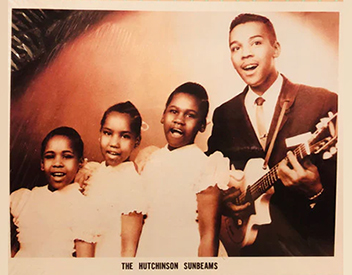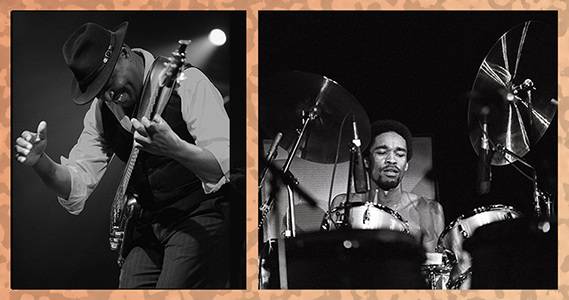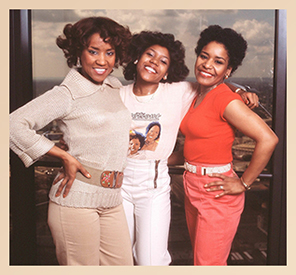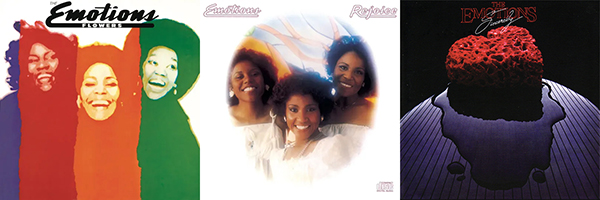

|
Soundclip:
|
| See
Steve Khan's Hand-Written Lead Sheet |
Steve Khan's Rhythm Composite Lead Sheet: "I Wouldn't Lie"(Jon Lind-Francine Tacker)
I believe that I first fell in love with the singing of The Emotions in 1976 when heard their song "Flowers"(Al McKay-Maurice White) from the album of the same name. That album was produced by Maurice White of Earth, Wind & Fire fame alongside Charles Stepney, who was a key figure in so much of the great music that had emanated from Chicago. We hold the key To the world's destiny Have you the feeling to shine your light Usin' the power, shinin' bright Love is a flower, from that a bud To spread its sunshine, and make us love Beautiful colors shinin' though Bless you, brother Oh, He's watching you Who amongst us cannot embrace those sentiments? 50 years later, we are still searching for this kind of flower power to rule the day. The innocence with which these sentiments of peace & love are expressed by The Emotions is so very touching to me. Though it took me some time to learn about the Hutchinson sisters and their father, Joe Hutchinson, remember, there was no internet back then, I eventually found out that the girls began singing with their father as "The Hutchinson Sunbeams" singing on the gospel circuit for years. Eventually, they became an R&B/Soul act with a popular following in their hometown of Chicago, Illinois. Not long afterwards they were renamed as The Emotions,  now managed by Pervis Staples (formerly with the Staple Singers), and they signed with the Memphis-based Volt imprint of Stax Records in the late 1960s. Their debut album, "SO I CAN LOVE YOU"(Stax)(1969) was produced by Isaac Hayes and David Porter. now managed by Pervis Staples (formerly with the Staple Singers), and they signed with the Memphis-based Volt imprint of Stax Records in the late 1960s. Their debut album, "SO I CAN LOVE YOU"(Stax)(1969) was produced by Isaac Hayes and David Porter.What brings us together here is the song, "I Wouldn't Lie" which appears on the 1978 album "SUNBEAM," the 3rd studio album for Columbia which contained the hit single, "Smile." I also have to mention that this romantic song appears on their 1999 compilation CD, "LOVE SONGS"(Columbia). I suppose some might consider "I Wouldn't Lie," written by Jon Lind and Francine Tacker, to be an album cut, meaning that it is a song that fills out the album, but that production is not expecting many people to focus their attention upon it. That notion feels very, very foreign to me as I was drawn to this song upon the first listening. I loved the vocals and the message in the lyrics. And those things were only enhanced by the fantastic arrangement, especially the rhythm section playing and shaping of the song as it moved along. I hadn't really studied the credits and personnel for this album in a long, long time. And as it turned out, these great players/arrangers included: Terry L. Mashall (Keys); Jon Lind & Marlo Henderson (Guitars); Gary Grainger (El. Bass); Fred White (Drums); Paulinho da Costa (Perc.); Victor Feldman (Vibes) with horns and strings arranged by: Tom Tom 84 (Thomas Washington). Sadly, the personnel credits are not song specific on the LP nor the CD, so I had to do some digging. And the results of my outreach were really fruitful. When some 50 years have come and gone since I first bought "SUNBEAM," I really didn't realize that Gary Grainger had played El. Bass on the album. Thinking about the superb bass playing on "I Wouldn't Lie" I began to listen and listen again in recent days and I realized that that bassist HAD TO BE Gary Grainger. And so, through my old pal and bandmate Dennis Chambers, I texted and e-mailed Gary about this tune and he told that it was, in fact, him playing the bass. I was really so excited to hear that. Musically speaking, it just made perfect sense. And it was Gary who told me that it was Fred White on drums, though he could not really remember much more about the actual rhythm date. Many of you will know of Gary's work with John Scofield's electric group from the mid-'80s and albums for Gramavision that included: "BLUE MATTER"(1987); "LOUD JAZZ"(1988); and "PICK HITS LIVE"(1990). If you are inspired to go back and see and hear Gary and Dennis with Sco' and Jim Beard, take a look at this CONCERT from 1988 in Hamburg, Germany. Or, the band's REUNION CONCERT(2017) @ Lincoln Center's Appel Room. Just fast-forward to about 30-minutes. All of this inspired me to actually put in the time and effort to see if I couldn't create a simple rhythm section composite lead sheet to salute just how magnificent the playing and the arrangement are on "I Wouldn't Lie"! And so, this is what I'm going to try to present to you all today in 2025. I would describe "I Wouldn't Lie" as a rhythmic ballad, still a love song. Any introduction, here Letter [I], sets the mood and the tone of what is to follow. There are just two chords, 2 bars each, Bbmaj7 to Abmaj7. Without giving anything away, the rhythm section work contains its own colors that will support the song and the lyrics throughout the entire piece. I was always struck, from the first time that I heard the song, by the 5ths that appear in bars 2 and 6. From an audio perspective, in the mix, which I like a lot, the parts are separated in stereo, left and right with an acoustic guitar, perhaps even an acoustic 12-string on the left side and another guitar plus vibes on the right side.  These sounds become a very particular sonic color that is as much a part of the song as anything. Arranger Tom Tom 84 introduces some wonderful warm shading with, as I hear it, trombones and muted trumpets which support the guitars. He also adds in long notes from the strings. It's a nice texture, one which will support Sheila's superb vocal throughout. These sounds become a very particular sonic color that is as much a part of the song as anything. Arranger Tom Tom 84 introduces some wonderful warm shading with, as I hear it, trombones and muted trumpets which support the guitars. He also adds in long notes from the strings. It's a nice texture, one which will support Sheila's superb vocal throughout.From a drums and percussion perspective, it should be noted that Fred White's drums are mixed from the "audience" perspective, which means that, for the listener, the hi-hat is on the right side of the mix. Fred plays his cross-stick on 1 & 3 and he opens and closes the hi-hat on the and-of-4. His kick drum is the most forcefully mixed part of his kit. What is either interesting or bothersome, is the fact that the we have a group of finger snaps are on beats 2 & 4. Finger snaps? These are usually things that songwriters might think of to keep the texture light so that the vocals can speak above it all. The truth is that those finger snaps go throughout the entire song and, in truth, are mixed louder than any part of Fred White's drum kit! Lastly, on the left side of the mix, we have the nice touch of percolation from the bongó. in the end, married to all of this is Gary Grainger's bass performance which becomes the most dynamic of all the instruments, his is a great performance that was allowed to speak through everything. Considering all of this, if one loves this song, as I do, the vocals and the lyrics, as they should, carry the song all the way. At the first letter [A], the texture thins out with the basic rhythm section elements continuing. The chords stay the same, Bbmaj7 to Abmaj7, 2 bars each, but on beats 3 & 4 of bar 8, there are two accents for the C/D chords. One could also write those chords as D7(9sus). As Letter [B] will transition to Gm7, the relative minor, the vi7 chord, one might expect to hear a preceding chord, some kind of D7 with alterations, but the lush sounds of C/D makes interesting because the E-natural and it feels as though we're going to an unusual harmonic place, when Gm7 is so very normal. I love the little horn touches in bar 3. In this new section, Sheila's voice sounds doubled to me and, for the 1st time, the beautiful harmonies of the Hutchinson sisters arrive in bar 5. As the song is building, the transition in bar 8 is handled, almost exclusively by Gary Grainger just playing Bb on beat 3 and B-natural on beat 4 with no chord above it. As we're headed to Cm7, there could have been a G7/B on beat 4, or even Bm7. But, it's just fine the way that it was played. Letter [C] contains a most interesting little rhythmic or meter touch as I have written it out with bar 2 being a 2/4 bar. The accented C/Bb chord on beat 4 of bar 1 is really a very normal accent that players are used to making, so it's interesting that a beat gets taken away from bar 2. All of this happens because of the rhythmic content of the lyrics, when they sing: "We got a thing......" That alone makes this little meter shift feel completely natural to me. From there, the song returns to 4/4 and the bass line continues to descend, which creates its own effects: Cm7-C/Bb-F/A-Abmaj7-Eb/G. In terms of texture, this is a section that is supported mostly by sustained strings. In the end, structurally, it's a strange little 11-bar section that comes to a hold on Eb/F in bar 11. From there, we are sent back to Letter [A]. [A2] with new lyric content is still very much the same as it was the 1st time, but in [B2], in bars 3-4, the little guitar and vibes figure is slightly different with syncopated 8th-notes, replacing what you see written from the 1st time. Now, the song heads for [C2] and here we have some wonderful foreshadowing of what is to come as Gary Grainger introduces some very light thumbing of his el. bass - just a hint of it as we are headed to take the 2nd Ending  which brings us to the first appearance of Letter [D] and here, Grainger unleashes the full funky power of thumbing and snapping of his bass strings making this section a fantastic pay-off within the message of the song. Shiela's vocal is supported by long string lines which are lightly doubled by vibes and maybe piano too. I love the sophisticated chord colors in bars 9-12 where you can hear the triad moving from Ab/Bb to G/Bb, which is really a Bb7(13b9) chord - but it is that harmonic motion that supplies the tension to pull us towards resolution at a very brief 4-bar [I2]. which brings us to the first appearance of Letter [D] and here, Grainger unleashes the full funky power of thumbing and snapping of his bass strings making this section a fantastic pay-off within the message of the song. Shiela's vocal is supported by long string lines which are lightly doubled by vibes and maybe piano too. I love the sophisticated chord colors in bars 9-12 where you can hear the triad moving from Ab/Bb to G/Bb, which is really a Bb7(13b9) chord - but it is that harmonic motion that supplies the tension to pull us towards resolution at a very brief 4-bar [I2].If you will recall, our Intro [I] was played with Bbmaj7 as the harmonic center, however with the transition from [C2] the 4-bar interlude which becomes [I2] lands on Ebmaj7(6), with a nice voicing on the keys, spelling up G-C-D, not shown on the lead sheet. And, as it is the IV chord of Bb, the guitars can still play the exact same figure in 5th in bar 2. So, as you have been following along with the song, it sounds as if nothing has changed, but something did change! At the end of bar 4, the same 2-beat transition of C/D on beats 3-4 to allow us to have a structural D.S. back to what is [B3] and [C3] with the 2nd Ending again, but this time, we are going to take the Coda which will take us to Letter [E] for the Fade. Letter [E] unveils itself with a 4-bar progression Abmaj7 to Ab/Bb to 2 bars of Ebmaj7. The nice keyboard figure in bar 1, rhythmically, it is the only time that it appears. And the guitars in bars 3 & 4 bring us a new figure and both of these touches help so much to keep the listener interested and engaged the entire way while Sheila's magical improvised singing explores the message of the song with the appropriate emotion! The layering of the background voices is just superb too - sounding like only this trio of young ladies can sound like. I also love the horns at the end, again (if they are trumpets and not flügelhorns) with a wonderful arranging touch that reminds me Burt Bacharach's arranging style. From the bottom end? Gary Grainger's thumpin' and stompin' el. bass brings everything together to drive the track, the song home. He was just the perfect player for this, bringing all the touches of the great Larry Graham to another area of R&B history. I wouldn't lie to you I'm feelin' sad Darling, let's talk it through We always had [B] When you're feeling there's no need to speak to me Don't give in to despair so easily [C] We got a thing, all the time and it means more than I can say I'm trying to bring the best I have to you [A2] I'm in love with you make no mistake dear and I will try to do more than just be near [B2] We can try, harm comes as it will most any day Take my hand before hope gets washed away [C2] [D] Though I'm getting tired tonight and I'm feeling sad enough inside to know I've got love that grows and makes my life seem whole and I'm gonna live this life with you No one loves me like you do and baby, that's the truth [I2] [B3] When you're feeling, when you're feeling Don't give in to despair so easily [C3] [Fade] I have to offer my Special Thanks to my longtime and dear friend, the great singer, Charlo Crossley (Miss Crossfire), who helped me with two words at the end of [A2] that I just couldn't figure out. And a big shout out to A. Scott Galloway, who solved the bigger mystery in [B2] - so grateful for that one!!! If it hasn't been obvious throughout this piece, I simply love The Emotions and their recordings. Many of the songs occupy hallowed places within my iTunes Library. Quite sometime ago, I actually wrote out a Rhythm Section Composite Lead Sheet for their song, "SINCERELY"(Red Label).  I just love everything about this song, and the arrangement. So, just like the song that I have focused on here, I found it to be a great learning experience writing it out, and trying to see how it was all put together. The song was produced by the songwriters, Billy Osborne and Zane Giles, and it was Giles who played all of the instruments on the track. Amazing! Where spectacular vocals, vocal harmonies, precise and very funky rhythm section playing (even if some it is programmed) and lush harmonies from the keyboards, one just can't ask for much more. The internal rhythmic accents are subtle and wonderfully conceived. For me, it is all beautifully done. In keeping with past Emotions' recordings, Giles' guitar sound is much like one might have expected from the great Al McKay. If you have stuck by me this far, I really hope that you have now enjoyed finding this surprise special musical treat hidden in plain sight. I just love this song! I just love everything about this song, and the arrangement. So, just like the song that I have focused on here, I found it to be a great learning experience writing it out, and trying to see how it was all put together. The song was produced by the songwriters, Billy Osborne and Zane Giles, and it was Giles who played all of the instruments on the track. Amazing! Where spectacular vocals, vocal harmonies, precise and very funky rhythm section playing (even if some it is programmed) and lush harmonies from the keyboards, one just can't ask for much more. The internal rhythmic accents are subtle and wonderfully conceived. For me, it is all beautifully done. In keeping with past Emotions' recordings, Giles' guitar sound is much like one might have expected from the great Al McKay. If you have stuck by me this far, I really hope that you have now enjoyed finding this surprise special musical treat hidden in plain sight. I just love this song!What better way to close out this presentation than with an a cappella performance by The Emotions of a hymn that appeared on their "FLOWERS" album, it is titled, "God Will Take Care of You" and was written by: Civilla & Walter Martin. It is only about :32 in length and simply states: God will take care of you I find the devout sincerity of Sheila, Wanda and Jeanette Hutchinson to be very, very moving. Though I have no such faith in anything, hearing this, the singing, the harmonies, the enunciation of the words always reaches me. As always, my most sincere "Thank you!" to everyone who visits these pages with regularity. PEACE, LOVE and FLOWER POWER!!! - Steve
[Photos: The Hutchinson Sunbeams by:
Gary Grainger & Fred White Collage by: The Emotions by: ] |